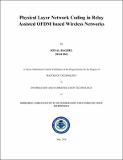Please use this identifier to cite or link to this item:
http://drsr.daiict.ac.in//handle/123456789/628Full metadata record
| DC Field | Value | Language |
|---|---|---|
| dc.contributor.advisor | Pillutla, Laxminarayana S. | |
| dc.contributor.author | Baghel, Sonal | |
| dc.date.accessioned | 2017-06-10T14:44:56Z | - |
| dc.date.available | 2017-06-10T14:44:56Z | - |
| dc.date.issued | 2016 | |
| dc.identifier.citation | Baghel, Sonal (2016). Physical layer network coding in relay assisted OFDM based wireless networks. Dhirubhai Ambani Institute of Information and Communication Technology, viii, 44p. (Acc.No: T00591) | |
| dc.identifier.uri | http://drsr.daiict.ac.in/handle/123456789/628 | - |
| dc.description.abstract | Relays have the potential to support transmissions over long distance ranges, much more<p/>than what can be accomplished by relay-less wireless networks. The concept of network coding<p/>(NC) that was originally conceived for wired networks can also be used for efficient<p/>communication in wireless networks, owing to the ubiquitous nature of wireless transmissions.<p/>Earlier, NC was applied only to the higher layers of protocol stack. Only recently researchers<p/>have started exploring network coding at physical (PHY) layer in which, instead of bits, signals<p/>are combined. In literature, PHY layer NC is also referred as symbol level network coding. In<p/>this thesis, we considered performance evaluation of PHY layer NC scheme in OFDM based<p/>relay assisted wireless networks. Specifically, we conducted simulation study by implementing a<p/>canonical scenario consisting of three nodes, of which two of them constitute source and sink<p/>nodes and one of them would act as a relay. The OFDM based PHY layer that we used is similar<p/>to the one that is used in IEEE 802.11a standard. The relay node uses the popular decode and<p/>forward joint modulation (DF-JM) technique, which as the name implies decode and forward<p/>mechanism combined with joint encoding of data received from both the nodes. The<p/>performance of DF-JM has been compared with the conventional decode and forward (DF)<p/>technique. Our simulation results suggest that DF-JM based PHY layer NC outperforms the<p/>conventional DF scheme across different scenarios of interest. We also considered the<p/>performance of DF-JM scheme with relay selection and power allocation. Our simulation results<p/>suggest that an equal power allocation among various relays gives better throughput values as<p/>against that of the scheme where relay selection is combined with optimal power allocation. This<p/>behaviour is contrary to what was observed in a related work where simple analog relays were<p/>considered. The relatively better performance of the equal power allocation based DF-JM<p/>scheme can be attributed largely to the less number of transmission slots that a DF-JM based<p/>scheme would require, along with the diversity advantage of having all the relays transmit. | |
| dc.publisher | Dhirubhai Ambani Institute of Information and Communication Technology | |
| dc.subject | Network Coding | |
| dc.subject | Decode and forward Joint Modulation | |
| dc.classification.ddc | 621.382 BAG | |
| dc.title | Physical layer network coding in relay assisted OFDM based wireless networks | |
| dc.type | Dissertation | |
| dc.degree | M. Tech | |
| dc.student.id | 201411042 | |
| dc.accession.number | T00591 | |
| Appears in Collections: | M Tech Dissertations | |
Files in This Item:
| File | Description | Size | Format | |
|---|---|---|---|---|
| 201411042.pdf Restricted Access | 3.8 MB | Adobe PDF |  View/Open Request a copy |
Items in DSpace are protected by copyright, with all rights reserved, unless otherwise indicated.
